Introducing the Revolution Vehicle Idle and Emission Reduction System, a revolution in emission and idle reduction technology for school buses. Developed to provide idle free operation of HVAC and all bus electrical accessories.
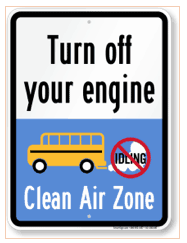 Vanner, the leader in vehicle power management for transit bus, has partnered with ACC/Valeo, leaders in innovative HVAC systems, to provide school buses with idle free air conditioning. This system utilizes Vanner experience in vehicle transformation and ACC’s expertise with efficient HVAC systems to provide a technology that can be used to run air conditioning and all necessary accessories with the engine off.
Vanner, the leader in vehicle power management for transit bus, has partnered with ACC/Valeo, leaders in innovative HVAC systems, to provide school buses with idle free air conditioning. This system utilizes Vanner experience in vehicle transformation and ACC’s expertise with efficient HVAC systems to provide a technology that can be used to run air conditioning and all necessary accessories with the engine off.
The Revolution Idle and Emission Reduction or system consists of ACC’s air conditioning, evaporator and condenser with a high-efficiency electric scroll compressor. This compressor has fewer moving parts making it last 3 times longer than a belt driven compressor. The compressor also eliminates extra long high pressure cooling hoses that run from the engine to the back of the bus. Many Class C school buses have two engine mounted compressors, the scroll compressor is a single zero maintenance unit.
The two engine-mounted compressors are replaced by a single high power engine mounted electric generator that has a 12 year life which provides the power.
The heart of the system is Vanner’s Supplemental Power System. Which includes a Vanner Power Module (VPM) that uses the engine mounted generator to control the electric compressor run the A/C and charge a set of long life Li-Ion batteries found within the Vanner Battery Module (VBM).
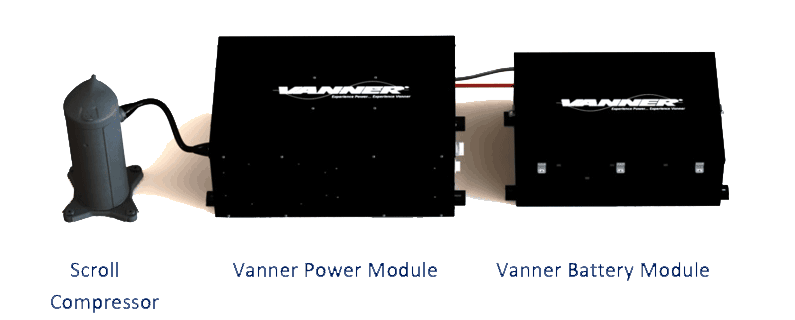
Once the vehicle’s engine is turned off the VPM uses the energy stored in the VBM to run the A/C system. The VPM manages the batteries’ power and maximizes A/C run time by optimizing how the A/C system consumes the power available. This system does not use the main battery nor does it interfere with the OEM electrical system. Vanner also provides power to run lights and the lift gate while the engine off.
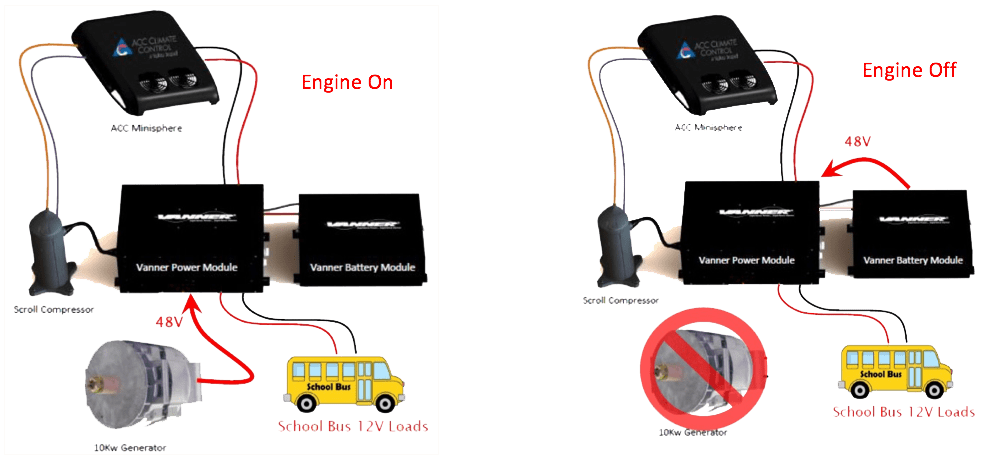
One key to the effectiveness of this system is the batteries. Li-Ion is known to be energy dense. This means they contain a large amount of energy in a small space. A typical car battery is around 750Wh while a Li-Ion of the same size holds twice the energy. Most PbA batteries have only 50% of their total energy available, while Li-Ion is 90%, therefore a 100AH PbA is actually only 50Ah. A Li-Ion system is low internal resistance which allows for faster charging. This ability to recharge quickly allows Vanner to have the battery back to full charge faster and therefore decreases idle times.
Li-Ion batteries do not suffer the same over charging problems lead acid batteries have that shorten their life. Since Li-Ion is an engineered system we can tell the battery’s State of Charge (SOC). We’ll know when the battery is running low and needs to be recharged. A LI-Ion battery can be cycled 3,000 to 4,000 times compared to the 300 to 400 cycles of a lead acid battery. The increase in cycles will allow Vanner’s system to perform at peak for much longer and offer 12 years of useful life.
As we have stated, the other key to this system is the VPM. Vanner uses its years of power management experience to optimize the A/C system. We look at a battery’s SOC then determine how close to the desired temperature the vehicle is. We can then lower the A/C power or adjust the fans to reduce energy draw. Since we have control over the fans and the compressor, it gives us the ability to maximize the A/C run time while the engine is off. The system also provides a warning to the driver when the batteries a running low and need to be recharged by starting the engine.
Working with ACC/Valeo allows Vanner to utilize state of the art air conditioning systems with their efficient scroll compressors. Below is a figure showing how that compressor allows us to provide a long life system (12 years) with maximum efficiency.
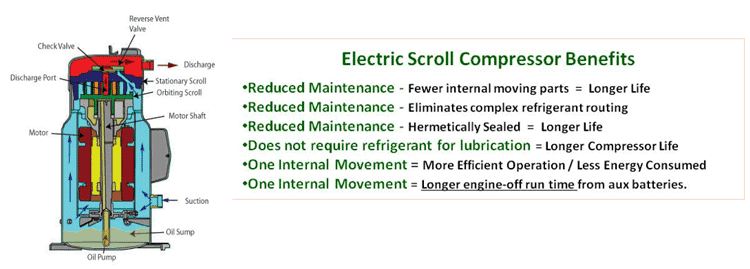
Since we remove two compressors from the engine and eliminate all the hoses we believe there is about $500 per year to save in maintenance costs, not to mention a reduction in down time to perform that maintenance. The scroll compressor should last 12 years or the life of the bus.

A second factor when looking at cost reduction is idle speed. Normally a bus needs to run at a high idle speed to support the air conditioning as it continues cooling. Revolution allows for cooling at lower idle speeds saving fuel. Below is a chart comparing fuel usage and emissions at low and high idle speeds.
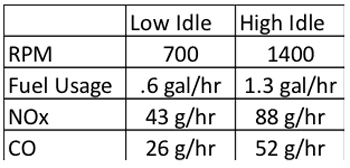 The number of hours per day a bus is in use ranges from 6 to 10 and the number of days per year averages 180. A typical bus idles about three hours per day with 90% occurring at high idle speeds. With our system running at low or curb idle we can save 2.0 gal/day, 360 gallons/year along with, 24,000 grams of NOx, and 14,000 grams of CO.
The number of hours per day a bus is in use ranges from 6 to 10 and the number of days per year averages 180. A typical bus idles about three hours per day with 90% occurring at high idle speeds. With our system running at low or curb idle we can save 2.0 gal/day, 360 gallons/year along with, 24,000 grams of NOx, and 14,000 grams of CO.
The length of time the battery provides cooling is dependent on the size of the compressor and number of condensers and evaporators, along with outside temperature and humidity. Vanner can help determine run time based on individual requirements, optionally offering larger batteries.
Revolution runs the A/C identical to standard A/C and completely transparent to the driver. To preserve battery power and lengthen the engine off time the VPM will adjust the frequency of the compressor to a lower value reducing energy loss by 10% or more. A critical factor is being able to maintain the bus’s internal temperature without running the engine.
A set of tests were conducted on a Blue Bird diesel Vision Bus. It was installed with two roof mounted ACC/Valeo Minisphere HVAC systems along with a smaller dash-board system. A total of 140K BTU being run off the same Scroll compressor powered by Revolution with fully charged batteries.
The bus temperature was maintained at 75°F with an outside temperature of 90°F. The VPM managed the compressor to insure cooling was maintained with as little power usage as possible. It lowered the compressor’s frequency and lengthened the time it can run without starting the bus’s engine. Under these extreme conditions Revolution maintained the temperature for 40 mins independent of the vehicle’s 12V battery.
Summary
- Significant reduction in idling while waiting in school zones
- Simple operation and Zero maintenance
- Designed to last the life of the bus
- Full power at low RPM Idle operation vs. high RPM idle to run air conditioning
- Maintenance cost reduction by replacing belt driven compressors and hoses
- Improved health outlook for children near school zones
- Take advantage of diesel reduction funding
Contact Carl Postiglione at carlp@vanner.com or 904-297-0942 for more information on idle-free HVAC and school bus electrical solutions.

















